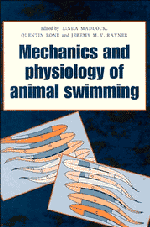Book contents
- Frontmatter
- Contents
- Contributors
- Introduction
- 1 Functional patterns of swimming bacteria
- 2 Buoyancy and swimming in marine planktonic protists
- 3 The role of fins in the competition between squid and fish
- 4 The biology of fish swimming
- 5 Swimming physiology of pelagic fishes
- 6 The mechanical design of the fish muscular system
- 7 How do fish use their myotomal muscle to swim? In vitro simulations of in vivo activity patterns
- 8 The timing of lateral muscle strain and EMG activity in different species of steadily swimming fish
- 9 Swimming in the lamprey: modelling the neural pattern generation, the body dynamics and the fluid mechanics
- 10 Swimming capabilities of Mesozoic marine reptiles: a review
- 11 Stone, bone or blubber? Buoyancy control strategies in aquatic tetrapods
- 12 Functional anatomy of the ‘flight’ apparatus in penguins
- 13 Energy conservation by formation swimming: metabolic evidence from ducklings
- Bibliography
- Index
12 - Functional anatomy of the ‘flight’ apparatus in penguins
Published online by Cambridge University Press: 05 March 2012
- Frontmatter
- Contents
- Contributors
- Introduction
- 1 Functional patterns of swimming bacteria
- 2 Buoyancy and swimming in marine planktonic protists
- 3 The role of fins in the competition between squid and fish
- 4 The biology of fish swimming
- 5 Swimming physiology of pelagic fishes
- 6 The mechanical design of the fish muscular system
- 7 How do fish use their myotomal muscle to swim? In vitro simulations of in vivo activity patterns
- 8 The timing of lateral muscle strain and EMG activity in different species of steadily swimming fish
- 9 Swimming in the lamprey: modelling the neural pattern generation, the body dynamics and the fluid mechanics
- 10 Swimming capabilities of Mesozoic marine reptiles: a review
- 11 Stone, bone or blubber? Buoyancy control strategies in aquatic tetrapods
- 12 Functional anatomy of the ‘flight’ apparatus in penguins
- 13 Energy conservation by formation swimming: metabolic evidence from ducklings
- Bibliography
- Index
Summary
Penguins are the best-adapted birds to wing-propelled diving and swimming. In water the weight of their perfectly streamlined body is balanced by buoyancy. Hence the strong ‘flight’ apparatus is used only for thrust production. Similarly to flying birds penguins flap their wings. But, contrary to fast flight in air, thrust is produced under water during the up-stroke as well as during the down-stroke. Corresponding wing profiles are developed. Since the wings are active in a permanently extended position, the shoulder joint is simplified. The examination of its structure and kinematics revealed a new type of articulation. The ‘rotation’ of the head of the humerus in the shoulder joint can be described as a two-axis-eccentric motion conducted by the ligamentum acrocoracohumerale and an articulation surface of the caput humeri shaped like a logarithmic spiral. This model led to new interpretations of the function of the muscle system. Besides the preponderant thrust-producing (flapping) muscles, working mainly isotonically, muscles can be distinguished which are managing the transfer to the body of the forces produced, thereby operating isometrically. Another group of muscles must control the position of the humerus, adjusting the hydrodynamic angle of attack corresponding to respective flow conditions. In kinematic studies conducted on live penguins, different modes of wing action were observed. The functional anatomical demands of the balance of forces and momentum are discussed with respect to the non-steady flow around the wings.
INTRODUCTION
A diverse range of animals use a special mode of swimming which, because of some similarities with the flight in air, is called ‘aquatic flight’.
- Type
- Chapter
- Information
- The Mechanics and Physiology of Animal Swimming , pp. 163 - 192Publisher: Cambridge University PressPrint publication year: 1994
- 28
- Cited by

